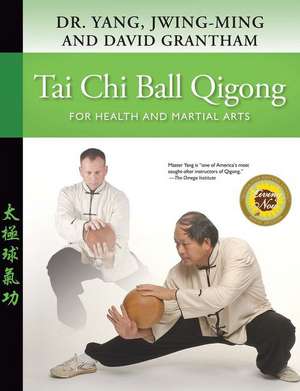Tai Chi Ball Qigong
Autor David W. Grantham, Jwing Ming Yangen Limba Engleză Hardback – 15 sep 2022
Preț: 259.80 lei
Nou
Puncte Express: 390
Preț estimativ în valută:
49.72€ • 51.36$ • 41.38£
49.72€ • 51.36$ • 41.38£
Carte disponibilă
Livrare economică 05-19 martie
Livrare express 18-22 februarie pentru 50.47 lei
Preluare comenzi: 021 569.72.76
Specificații
ISBN-13: 9781594397653
ISBN-10: 1594397651
Pagini: 315
Dimensiuni: 198 x 246 x 28 mm
Greutate: 0.8 kg
Editura: YMAA Publication Center
ISBN-10: 1594397651
Pagini: 315
Dimensiuni: 198 x 246 x 28 mm
Greutate: 0.8 kg
Editura: YMAA Publication Center
Notă biografică
Dr. Yang, Jwing-Ming started his Gongfu training at the age of 15 under the Shaolin White Crane Master Cheng, Gin Gsao. Dr. Yang became an expert in the White Crane style of Chinese martial arts. With the same master he also studied Qin Na, Tui Na and Dian Xue massages, and herbal treatment.
At the age of 16, Dr. Yang began the study of Taijiquan under Master Kao, Tao. Dr. Yang's tai chi can be traced back to the Yang family through Master Kao's teacher Yue, Huanzhi, an indoor disciple of Yang, Chengfu.
After learning from Master Kao, Dr. Yang continued his study and research of Taijiquan. Dr. Yang has mastered the Taiji barehand sequence, pushing hands, the two-man fighting sequence, Taiji sword, Taiji saber, and Taiji Qigong.
Dr. Yang has been involved in Chinese Gongfu since 1961. During this time, he has spent 13 years learning Shaolin White Crane, Shaolin Long Fist, and Taijiquan. Dr. Yang has more than thirty years of instructional experience.
At the age of 16, Dr. Yang began the study of Taijiquan under Master Kao, Tao. Dr. Yang's tai chi can be traced back to the Yang family through Master Kao's teacher Yue, Huanzhi, an indoor disciple of Yang, Chengfu.
After learning from Master Kao, Dr. Yang continued his study and research of Taijiquan. Dr. Yang has mastered the Taiji barehand sequence, pushing hands, the two-man fighting sequence, Taiji sword, Taiji saber, and Taiji Qigong.
Dr. Yang has been involved in Chinese Gongfu since 1961. During this time, he has spent 13 years learning Shaolin White Crane, Shaolin Long Fist, and Taijiquan. Dr. Yang has more than thirty years of instructional experience.
Cuprins
Foreword
Preface
How To Use This Book
Chapter 1: General Qigong Theory
1.1 Introduction
1.2 What is Qi and What is Qigong?
1.3 Categories of Qigong
1.4 Theory of Yin and Yang, Kan and Li
1.5 Qigong and Health
1.6 Qigong and Longevity
Chapter 2: Qigong Training Theory and Procedures
2.1 Introduction
2.2 Five Regulatings
Chapter 3: General Introduction to Taiji Ball Qigong
3.1 Introduction
3.2 History of Taiji Ball Qigong
3.3 Taiji Ball Qigong and Health
3.4 Taiji Ball Qigong and Martial Arts
Chapter 4: Theory of Taiji Ball Qigong
4.1 Introduction
4.2 What is Taiji in Taiji Ball Qigong?
4.3 Theory of Physical Conditioning
4.4 Theory of Inner Qi's Cultivation
4.5 Martial Grand Qi Circulation
4.6 Other Benefits
4.7 Conclusions
Chapter 5: Taiji Ball Qigong Training
5.1 Introduction
5.2 Taiji Ball Qigong Training Contents and Procedures
5.3 Warm-Up
5.4 Internal Training ?Breathing Exercises
5.5 External Training ?Fundamental Stances
5.6 External Training ?Exercises
Chapter 6: Applications of Taiji Ball Qigong
6.1 Introduction
6.2 Self-Practice
6.3 Train with Partners
6.4 Advanced Taiji Ball Training
Conclusion
Appendix A: Translations and Glossary of Chinese Terms
Index
About the Author
Preface
How To Use This Book
Chapter 1: General Qigong Theory
1.1 Introduction
1.2 What is Qi and What is Qigong?
1.3 Categories of Qigong
1.4 Theory of Yin and Yang, Kan and Li
1.5 Qigong and Health
1.6 Qigong and Longevity
Chapter 2: Qigong Training Theory and Procedures
2.1 Introduction
2.2 Five Regulatings
Chapter 3: General Introduction to Taiji Ball Qigong
3.1 Introduction
3.2 History of Taiji Ball Qigong
3.3 Taiji Ball Qigong and Health
3.4 Taiji Ball Qigong and Martial Arts
Chapter 4: Theory of Taiji Ball Qigong
4.1 Introduction
4.2 What is Taiji in Taiji Ball Qigong?
4.3 Theory of Physical Conditioning
4.4 Theory of Inner Qi's Cultivation
4.5 Martial Grand Qi Circulation
4.6 Other Benefits
4.7 Conclusions
Chapter 5: Taiji Ball Qigong Training
5.1 Introduction
5.2 Taiji Ball Qigong Training Contents and Procedures
5.3 Warm-Up
5.4 Internal Training ?Breathing Exercises
5.5 External Training ?Fundamental Stances
5.6 External Training ?Exercises
Chapter 6: Applications of Taiji Ball Qigong
6.1 Introduction
6.2 Self-Practice
6.3 Train with Partners
6.4 Advanced Taiji Ball Training
Conclusion
Appendix A: Translations and Glossary of Chinese Terms
Index
About the Author
